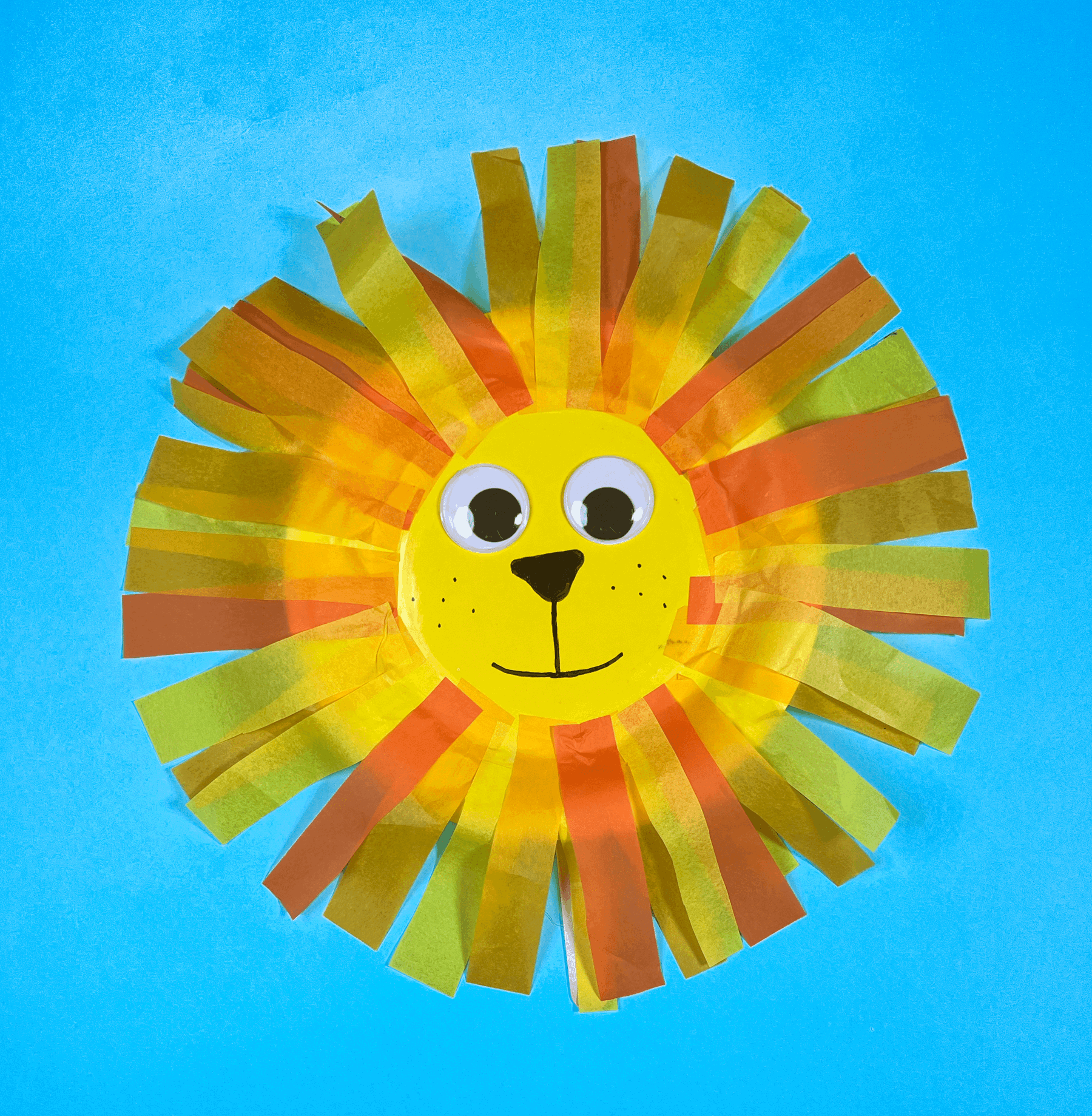
Make a lion mask to celebrate Vaisakhi
You’ll need
- Scissors
- Glue sticks
- Something to protect surfaces (for example, newspaper or tablecloths)
- Paper plates
- PVA glue
- Rulers
- Pens or pencils
- Paint brushes
- Orange, light brown and yellow card
- Orange, light brown and yellow tissue paper
- Orange and yellow paint
- Black marker pen
- Black card or felt
- Googly eyes
- Paint sponges
- Something to hold paint in
- Something to wash brushes in and dry them
Scouts is open to everyone. We don’t identify exclusively with one faith, and we welcome people of all faiths and of none.
We know it’s important for people to learn about each other, including understanding different faiths and beliefs. Scouts always respects people’s beliefs, faiths and cultures, and everyone should be open to learn.
As an inclusive and values based movement, we support our members to engage and learn about different faiths and beliefs in an exciting and meaningful way, even if they don’t have a faith themselves.
Celebrating and understanding differences, including differences in faiths and beliefs, is an important part of our Scout values, which are:
- Integrity: We act with integrity; we are honest, trustworthy and loyal.
- Respect: We have self-respect and respect for others.
- Care: We support others and take care of the world in which we live.
- Belief: We explore our faiths, beliefs and attitudes.
- Co-operation: We make a positive difference; we co-operate with others and make friends.
Our value of Belief and its exploration helps Scouts to learn from other faiths and beliefs. This encourages them to develop or build their personal beliefs and understand their shared values, whether faith-based on not.
We know that learning about faiths, beliefs and different attitudes can help to break down barriers, helps us all to recognise what we have in common, and teaches us to value and respect other people. It also helps us to build up respect, acceptance and knowledge for each other, leading to a more co-operative and inclusive society.
In our diverse society, people can sometimes feel cautious talking about this sensitive subject. However, it's important that Scouts offers young people safe, exciting and open spaces to explore faiths and beliefs. They should be able to engage in personal reflection, as they question and develop their opinions and understanding of the world around them.
Making time for personal reflection and developing our beliefs means exploring the places, people, communities, celebrations or stories which hold meaning for us, and it may not necessarily mean exploring a faith.
For example, someone’s shared values may be their Scout Values and that person may choose to reflect on them at important times, such as when they make their Promise. Others may choose to reflect at certain times of the year, such as a faith-based festival, birthdays, meaningful events or at New Year. Some people may still celebrate events, such as Christmas, but use it as a time to celebrate family, friends and loved ones, as well as for charity and giving.
Discover more about Faiths and Beliefs in Scouts.
- Vaisakhi’s is a harvest festival which celebrates the founding of the Sikh community, the Khalsa, in 1699. It’s also known as Baisakhi.
- It’s celebrated throughout North India, as well as around the world, and it marks the start of Spring.
- The celebrations include dancing, singing, colour and music.
- It usually happens on the 13 or 14 April every year.
- Vaisakhi’s celebrated by Sikhs around the world.
- Vaisakhi has been a harvest festival in Punjab - an area of northern India for a long time.
- In 1699, Sikhs from all over the Punjab, in India, gathered to celebrate the local harvest festival of Vaisakhi.
- There was a ceremony by the tenth guru, Guru Gobind Singh.
- He came out of a tent carrying a sword and said, ‘if you want to follow the path unconditionally, you can come into the tent’.
- Guru Gobind Singh then asked for people to step forward.
- One man went into the tent with him.
- Soon Guru Gobind Singh came out of the tent alone, his sword covered in blood.
- Guru Gobind Singh then asked for another volunteer. This happened several times, until five Sikhs had gone into the tent.
- Everyone was very worried they had been killed by Guru Gobind Singh.
- However, the five men came out of the tent alive.
- The five men became known as the 'Beloved Five'.
- Guru Gobind Singh initiated all the men into the Khalsa, which means ‘pure’.
- The Khalsa is a group of pure people. He said prayers and anointed them with a holy water called Amrit.
- He then requested the ‘Beloved Five’ to initiate him into the Khalsa panth (Path).
- Being initiated is now an important stage of being a Sikh.
Before you begin
- Use the safety checklist to help you plan and risk assess your activity. Additional help to carry out your risk assessment, including examples.
- Make sure all young people and adults involved in the activity know how to take part safely.
- Make sure you’ll have enough adult helpers. You may need some parents and carers to help if you’re short on helper
Setting up the activity
- You might want to set up the paints or glue before starting this activity.
- You may want to pre-cut items, such as the noses or strips, before this activity is run.
Making the lion's face
- Gather everyone together.
- If you’re doing this activity for Vaisakhi, take time to explain what it is.
- Explain that you’re going to be making a lion.
- Everyone should take a paper plate and paint it yellow, orange or any lion colour they’d like. Use a sponge and paint the paper plate by lightly dabbing the surface and blending the colours. You could also colour the plate in, or use glue and paper/card to collage a yellow-orange background.
- The plate can then be put to one side to dry.
- To create the nose, use scissors to cut a triangle out of the black card or felt. Glue the triangle in the middle of the paper plate, after the plate has dried.
- Now, add two googly eyes in any of the space above nose. Then, use the black marker pen to draw a mouth. You can add some dots around the nose and mouth for whiskers, too.
- It’s time to make the lion’s mane – you can use paper or tissue paper!
Option 1: Making the mane out of paper
- Cut orange, light brown and yellow paper in half across the middle, going horizontally.
- Now, cut the paper into strips, about 4cm wide.
- When the plate is dry, glue the strips of yellow and orange paper around the outer edge of the paper plate.
- Curl the strips by rolling them toward the paper plate and releasing the rolls. You could roll them around a pen or pencil to make it easier.
- Glue a second row of yellow and orange paper strips and, again, curl those strips to finish making the lion’s mane.
Option 2: Making the mane out of tissue paper
- Cut orange, light brown and yellow tissue paper into strips, about 4cm wide and 10cm long.
- When the plate is dry, glue the tissue paper strips around the edge of the paper plate.
- Keep building it up until it forms the lion’s mane.

Reflection
Singh is the surname given to every Sikh man on Vaisakhi in 1699. Singh implies a status of great majestic courage, even divinity, and it means Lion. Why do you think this may have been chosen as the surname?
How much did you know about Sikhism or Vaisakhi before this activity? What have you learned?
We made some paper plate lions. Did you enjoy making the lions? What was easy? Did you find anything difficult? How did you manage to keep going and not give up, even if it was hard?
Safety
All activities must be safely managed. You must complete a thorough risk assessment and take appropriate steps to reduce risk. Use the safety checklist to help you plan and risk assess your activity. Always get approval for the activity, and have suitable supervision and an InTouch process.
- Glue and solvents
Always supervise young people appropriately when they’re using glue and solvent products. Make sure there’s plenty of ventilation. Be aware of any medical conditions that could be affected by glue or solvent use and make adjustments as needed.
- Scissors
Supervise young people appropriately when they’re using scissors. Store all sharp objects securely, out of the reach of young people.
To make it easier, you could have the noses or strips of paper and tissue paper pre-cut.
- If someone is struggling with the arts and crafts section of this activity, they could work with a partner, so they can help each other. An adult volunteer or young leader could offer help with drawing, cutting, and threading elastic if anyone needs it.
- There are lots of different ways to be creative. People can choose what works best for them, or just what they most enjoy.
- If anyone struggles with fine motor skills, they could use larger materials. You could swap out the items for something easier to handle. You could also give them the opportunity to work in pairs with another young person, with a young leader or an adult volunteer.
- Make sure that all the materials are at a level that can be easily worked on by wheelchair users.
- For anyone who may not be able to hear the instructions, consider printing them a version that they can read at the same time.
All Scout activities should be inclusive and accessible.
You could turn the lion paper plates into masks. With an adult, make a hole either side of the paper plate, carefully cut out two eye holes and tie elastic from one side of the plate to the other. Make sure to measure the elastic carefully!
You could stick the paper plate to a skewer or lollipop stick to make a simple mask, too.
Let everyone use whichever colours and craft materials they want to make their lion. They could be creative and make a blue, red or rainbow lion!



